First Digits’ Shannon Entropy
Abstract
1. Introduction
2. The Newcomb–Benford Distribution
2.1. Entropy of the Newcomb–Benford Distribution
2.2. Non-NB Distributions
3. Mass Distributions of Minerals
3.1. Fragments of Marble
Why Is the Number 1 So Strong in The Majority of Cases?
3.2. Fragments of Calcite
3.3. Fragments of Granite
4. Prices of Shares and Equity Funds
5. Craters on the Venus
6. Results
Funding
Conflicts of Interest
Appendix A. First Digits’ Distribution of Exponentially Growing Objects
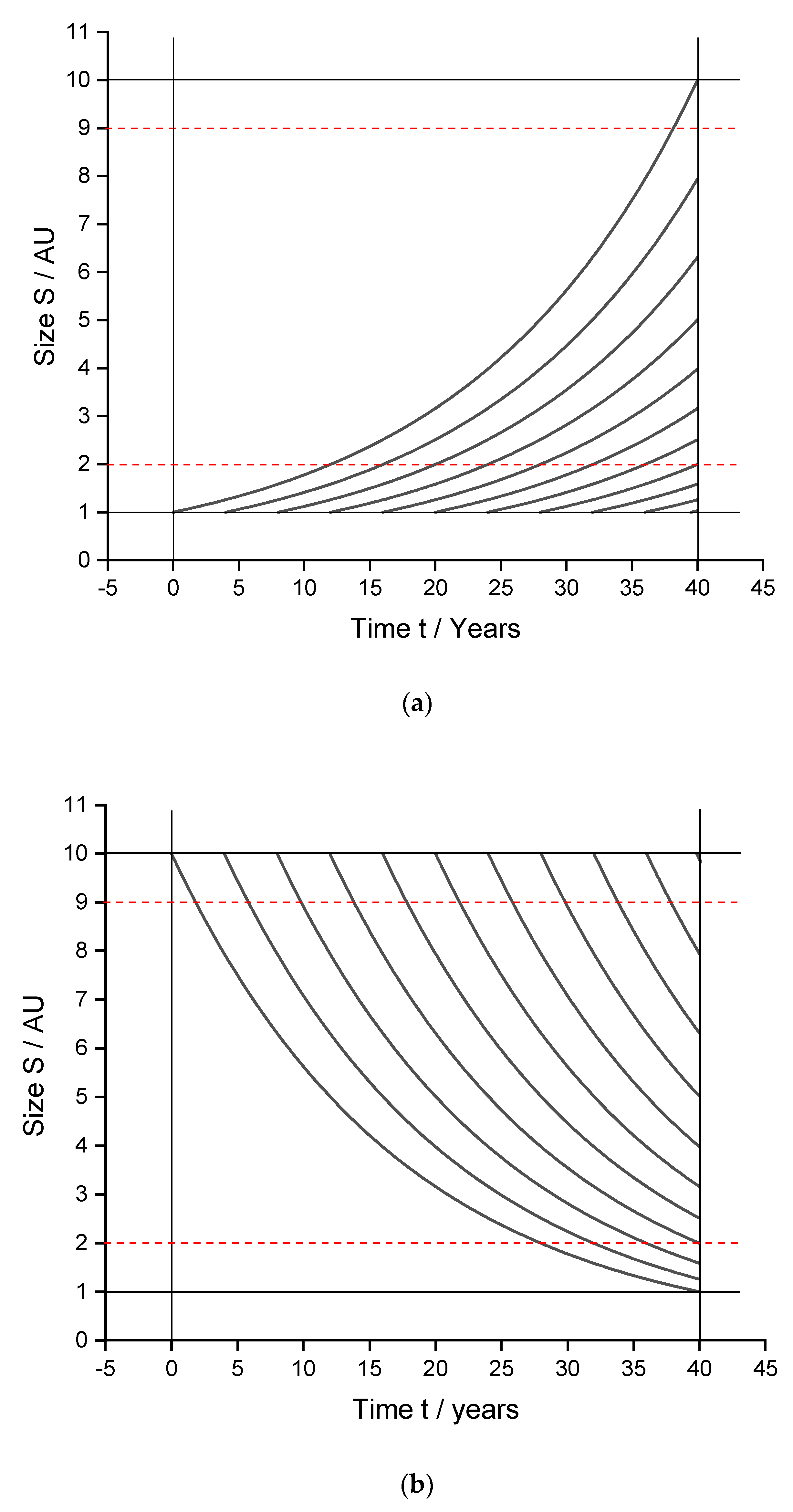
References
- Available online: https://en.wikipedia.org/wiki/Entropy_(information_theory) (accessed on 20 June 2022).
- Clausius, J.E.C. Available online: https://www.britannica.com/biography/Rudolf-Clausius (accessed on 17 August 2022).
- Available online: https://en.wikipedia.org/wiki/Boltzmann%27s_entropy_formula (accessed on 1 September 2022).
- Shannon, C.E. A Mathematical Theory of Communication. Bell Syst. Tech. J. 1948, 27, 379–423. [Google Scholar] [CrossRef]
- Shannon, C.E. Prediction and Entropy of Printed English. Bell Syst. Tech. J. 1951, 30, 50–64. [Google Scholar] [CrossRef]
- Kwiatkowski, S. Entropy Is a Measure of Uncertainty. Available online: https://towardsdatascience.com/entropy-is-a-measure-of-uncertainty-e2c000301c2c (accessed on 20 June 2022).
- Available online: https://www.tf.uni-kiel.de/matwis/amat/mw1_ge/kap_5/advanced/t5_3_2.html (accessed on 13 June 2022).
- Schöning, U. Algorithmik; Springer Spektrum: Berlin/Heidelberg, Germany, 2011; ISBN 9783827427991. [Google Scholar]
- Schöning, U. Mathe-Toolbox. 3., Überarbeitete Auflage; Lehmanns Media: Berlin/Heidelberg, Germany, 2011. [Google Scholar]
- Newcomb, S. Note on the Frequency of Use of the Different Digits in Natural Numbers. Am. J. Math. 1881, 4, 39–40. [Google Scholar] [CrossRef]
- Benford, F. The Law of Anomalous Numbers. Proceed. Am. Phil. Soc. 1938, 78, 551–572. [Google Scholar]
- Available online: https://en.wikipedia.org/wiki/Benford%27s_law (accessed on 21 July 2022).
- Hill, T.P. A Statistical Derivation of the Significant-Digit Law. Statist. Sci. 1995, 10, 354–363. [Google Scholar] [CrossRef]
- Stylometry and Numerals Usage: Benford’s Law and Beyond. Available online: https://encyclopedia.pub/entry/17716 (accessed on 17 August 2022).
- Biau, D. The First-Digit Frequencies in Data of Turbulent Flows. Phys. A Stat. Mech. Its Appl. 2015, 440, 147–154. [Google Scholar] [CrossRef]
- Kreiner, W.A. On the Newcomb-Benford Law. Z. Nat. 2003, 58a, 618–622. [Google Scholar] [CrossRef]
- Posch, P.N.; Kreiner, W.A. Analysing digits for portfolio formation and index tracking. J. Asset Manag. 2006, 7, 69–80. [Google Scholar] [CrossRef]
- Available online: https://en.wikipedia.org/wiki/List_of_craters_on_Venus (accessed on 20 June 2022).

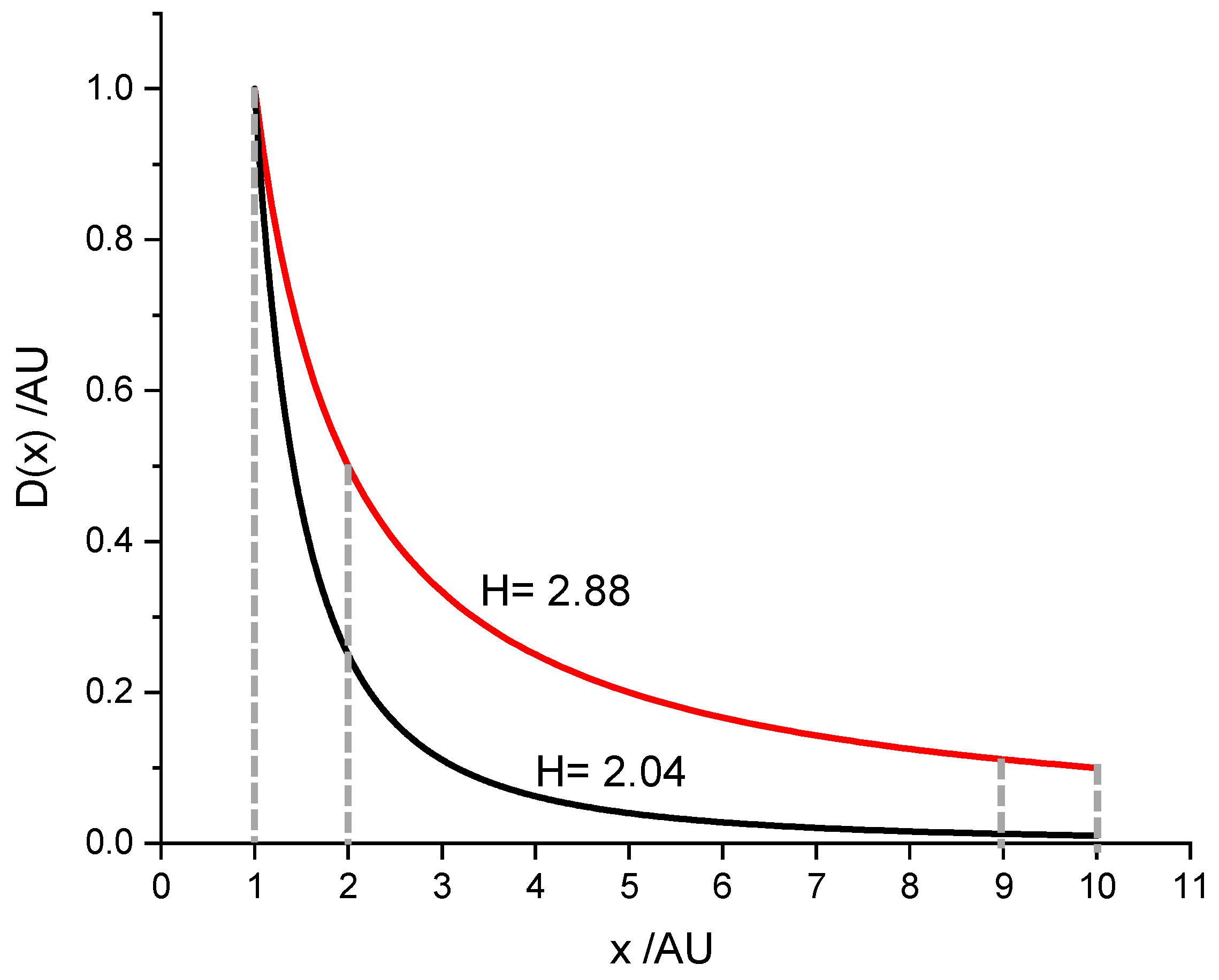

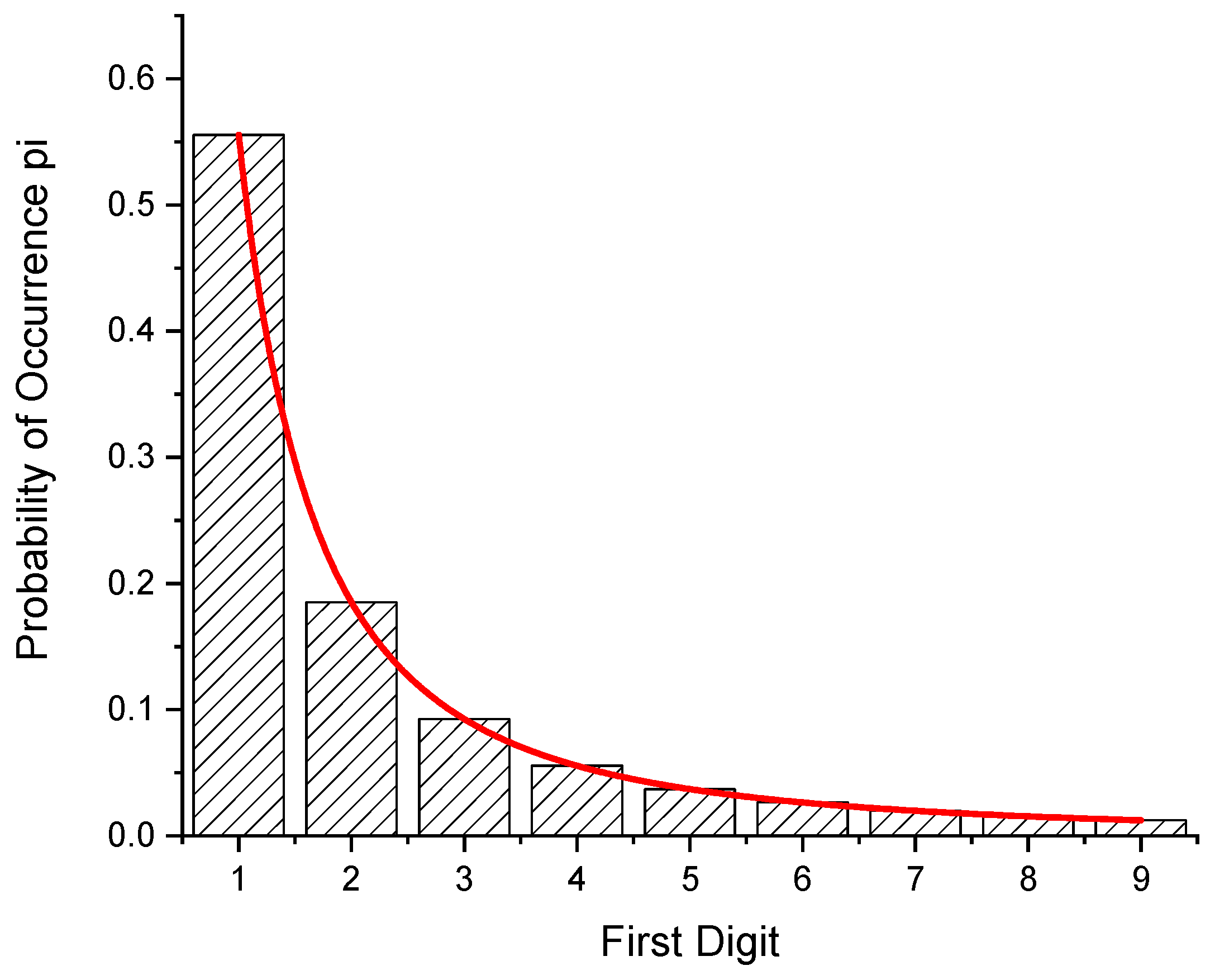
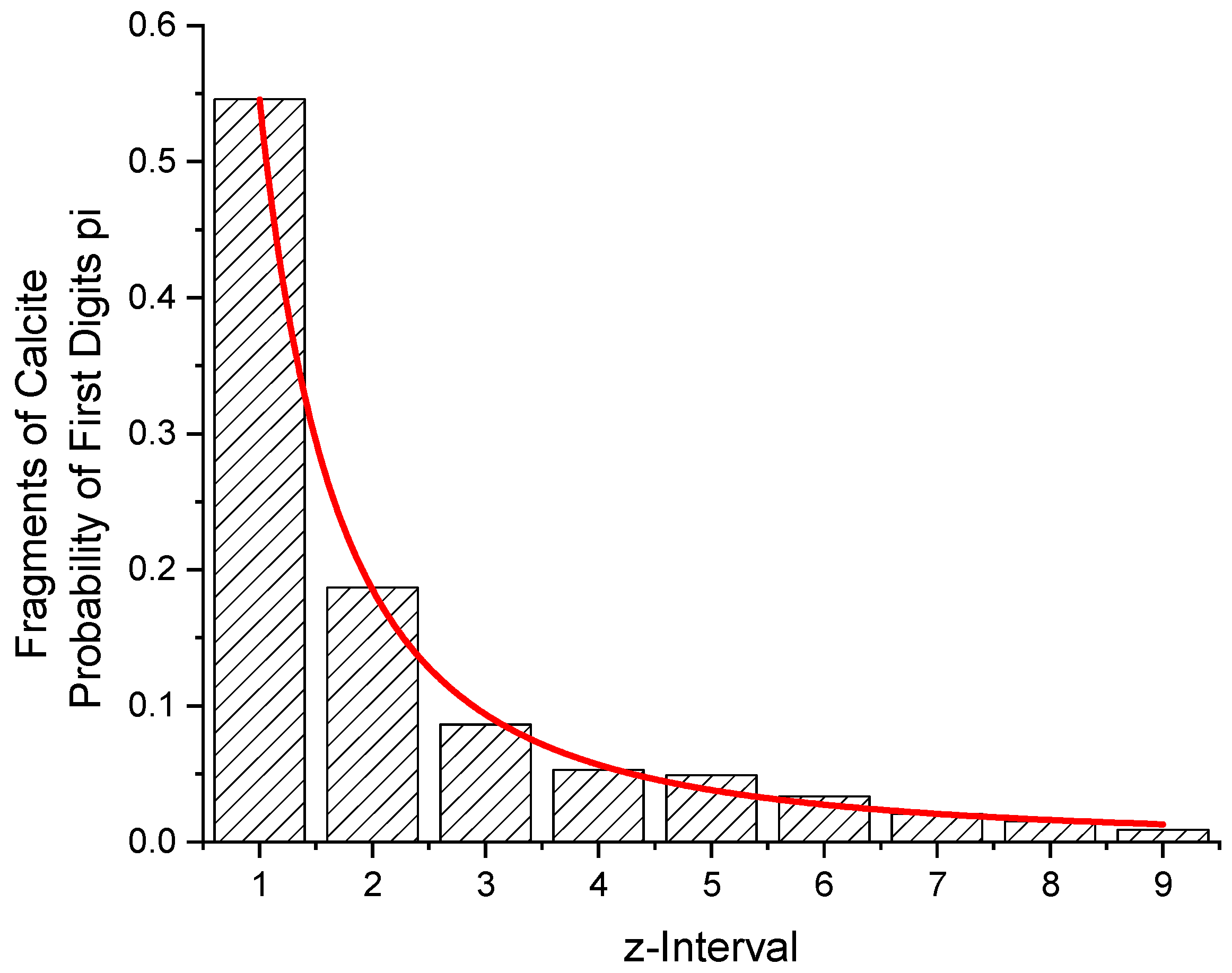
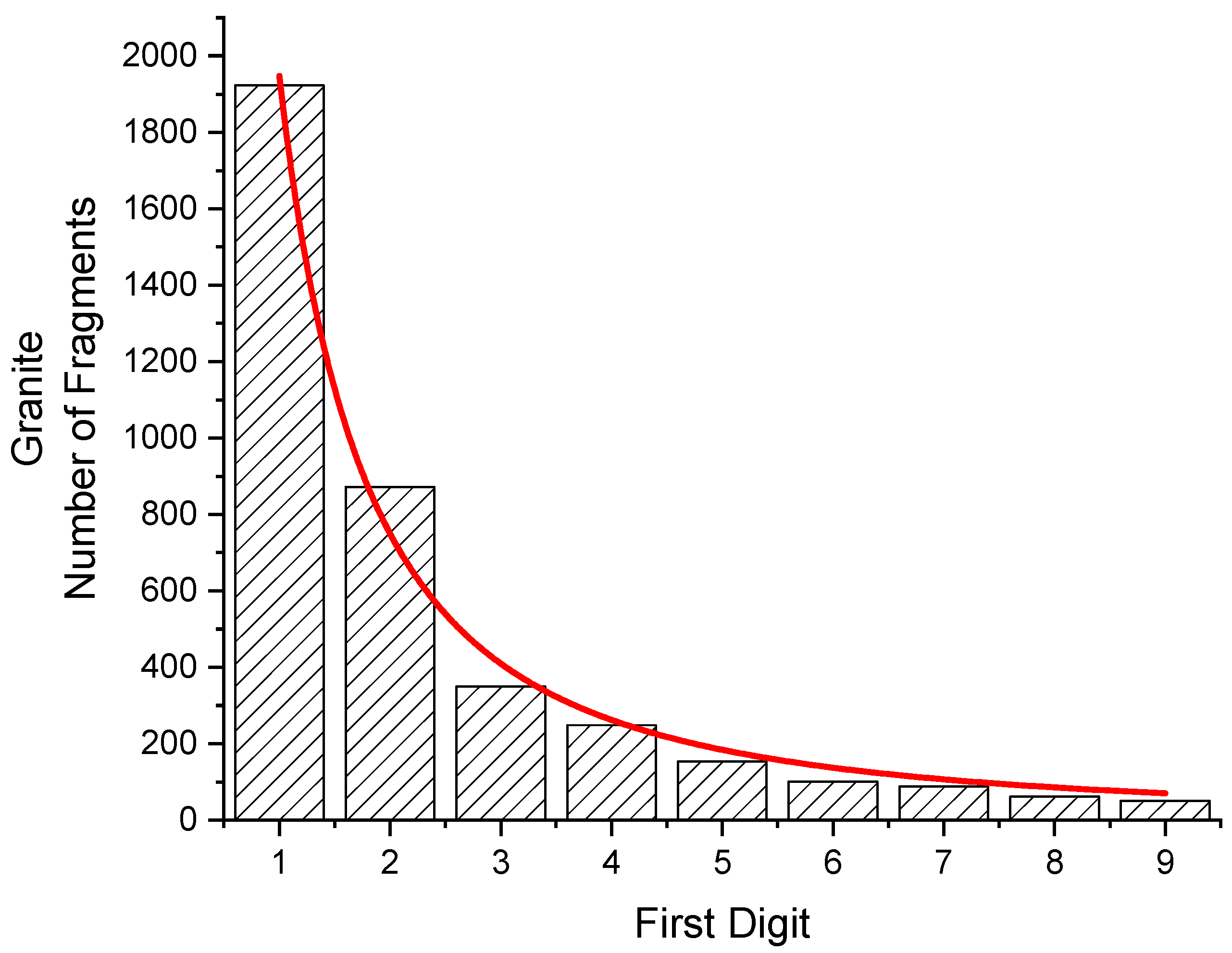
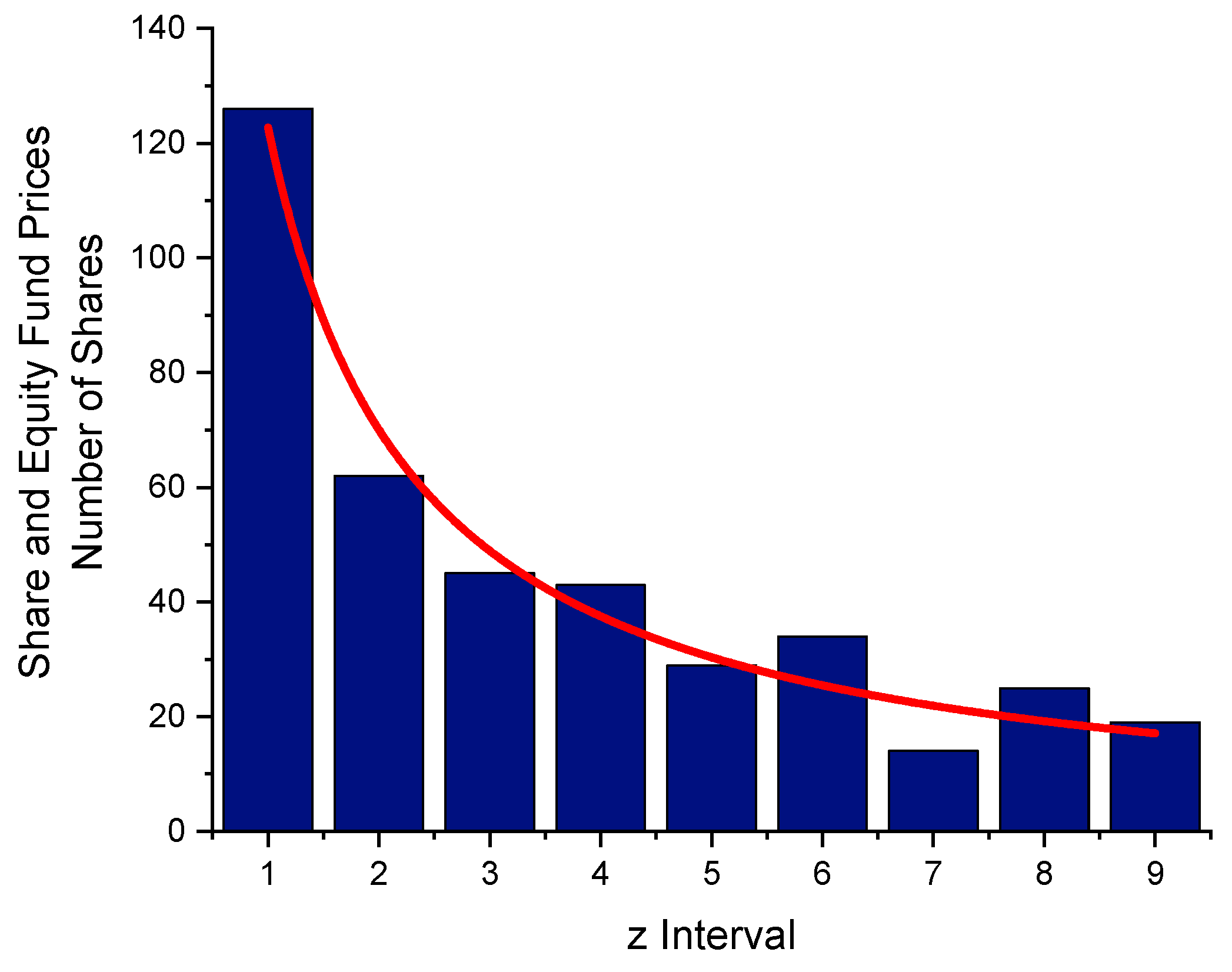

| a = z | b | pi | −pi ld pi | |
|---|---|---|---|---|
| 1 | 0.6931 | 2 | 0.3010 | 0.5214 |
| 2 | 0.4055 | 3 | 0.1761 | 0.4412 |
| 3 | 0.2877 | 4 | 0.1249 | 0.3748 |
| 4 | 0.2231 | 5 | 0.0969 | 0.3263 |
| 5 | 0.1823 | 6 | 0.0792 | 0.2897 |
| 6 | 0.1542 | 7 | 0.0670 | 0.2613 |
| 7 | 0.1335 | 8 | 0.0580 | 0.2383 |
| 8 | 0.1178 | 9 | 0.0512 | 0.2195 |
| 9 | 0.1054 | 10 | 0.0458 | 0.2037 |
| ∑ | 2.3026 | 1.0001 | H = 2.8762 bits per digit |
| z Interval | Number of Fragments | pi | −pi ld pi |
|---|---|---|---|
| 1 | 588 | 0.5589 | 0.4691 |
| 2 | 197 | 0.1873 | 0.4526 |
| 3 | 100 | 0.0951 | 0.3227 |
| 4 | 58 | 0.0551 | 0.2305 |
| 5 | 33 | 0.0314 | 0.1567 |
| 6 | 35 | 0.0333 | 0.1633 |
| 7 | 19 | 0.0181 | 0.1046 |
| 8 | 12 | 0.0114 | 0.0736 |
| 9 | 10 | 0.0095 | 0.0638 |
| ∑ | 1052 | 1.0001 | H = 2.0370 bits per digit |
| Number of Fragments | 1 | 2 | 3 | 4 | 5 | 6 | 7 | 8 | 9 |
|---|---|---|---|---|---|---|---|---|---|
| 9 | 1 | ||||||||
| 10 | 1 | ||||||||
| 11 | 1 | ||||||||
| 12–13 | 2 | ||||||||
| 14–16 | 3 | ||||||||
| 17–20 | 4 | ||||||||
| 21–27 | 8 | ||||||||
| 28–40 | 13 | ||||||||
| 41–81 | 42 | ||||||||
| 82–90 | 9 | ||||||||
| 91–101 | 11 | ||||||||
| 102–116 | 15 | ||||||||
| 117–135 | 19 | ||||||||
| 136–162 | 27 | ||||||||
| 163–203 | 41 | ||||||||
| 204–271 | 68 | ||||||||
| 272–407 | 136 | ||||||||
| 408–814 | 407 | ||||||||
| 815–905 | 91 | ||||||||
| 906–1018 | 113 | ||||||||
| 1019–1163 | 145 | ||||||||
| 1164–1357 | 194 | ||||||||
| 1358–1629 | 272 | ||||||||
| 1630–2036 | 407 | ||||||||
| 2037–2715 | 679 | ||||||||
| 2716–4073 | 1358 | ||||||||
| 4074–8147 | 4074 | ||||||||
| 8148–9052 | 905 | ||||||||
| 9053–10,184 | 1132 | ||||||||
| 10,185–11,639 | 1455 | ||||||||
| 11,640–13,579 | 1940 | ||||||||
| 13,580–16,295 | 2716 | ||||||||
| 16,296–20,368 | 4073 | ||||||||
| 20,369–27,158 | 6790 | ||||||||
| 20,159–40,737 | 13,579 | ||||||||
| 40,738–81,475 | 40,738 | ||||||||
| ∑ | 45,265 | 15,088 | 7545 | 4526 | 3018 | 2155 | 1616 | 1257 | 1006 |
| 1 | 2 | 3 | 4 | 5 | 6 | 7 | 8 | 9 | |
| pi | 0.55556 | 0.18518 | 0.09260 | 0.05555 | 0.03704 | 0.02645 | 0.01983 | 0.01543 | 0.01235 |
| Ratio 1 vs. 9: 45265/1006 = 44.995 Entropy H = 2.0692 |
| z Interval | Number of Fragments | pi | −pi ld pi |
|---|---|---|---|
| 1 | 423 | 0.5458 | 0.4768 |
| 2 | 145 | 0.1871 | 0.4524 |
| 3 | 67 | 0.0865 | 0.3053 |
| 4 | 41 | 0.0529 | 0.2243 |
| 5 | 38 | 0.0490 | 0.2133 |
| 6 | 26 | 0.0336 | 0.1643 |
| 7 | 16 | 0.0207 | 0.1256 |
| 8 | 12 | 0.0155 | 0.0931 |
| 9 | 7 | 0.0090 | 0.0613 |
| ∑ | 775 | 1.0001 | H = 2.1064 bits per digit |
| z Interval | Number of Fragments | pi | −pi ld pi |
|---|---|---|---|
| 1 | 1923 | 0.4996 | 0.5002 |
| 2 | 872 | 0.2266 | 0.4853 |
| 3 | 350 | 0.0909 | 0.3145 |
| 4 | 248 | 0.0644 | 0.2549 |
| 5 | 154 | 0.0400 | 0.1858 |
| 6 | 102 | 0.0262 | 0.1378 |
| 7 | 88 | 0.0229 | 0.1246 |
| 8 | 62 | 0.0161 | 0.0959 |
| 9 | 51 | 0.0133 | 0.0827 |
| ∑ | 3849 | 1.0000 | H = 2.1817 bits per digit |
| First Digit | 1 | 2 | 3 | 4 | 5 | 6 | 7 | 8 | 9 | ∑ |
| Frequency | 126 | 62 | 45 | 43 | 29 | 34 | 14 | 25 | 19 | 397 |
| pi | 0.3174 | 0.1562 | 0.1134 | 0.1083 | 0.0730 | 0.0856 | 0.0353 | 0.630 | 0.0479 | 1.0001 |
| −pi (ld pi) | 0.523 | 0.407 | 0.338 | 0.309 | 0.325 | 0.278 | 0.148 | 0.219 | 0.294 | |
| H = 2.841 bits per digit | ||||||||||
| First Digit | 1 | 2 | 3 | 4 | 5 | 6 | 7 | 8 | 9 | ∑ |
| Frequency | 314 | 151 | 92 | 64 | 60 | 52 | 63 | 30 | 48 | 874 |
| pi | 0.3593 | 0.1728 | 0.1053 | 0.0732 | 0.0686 | 0.0595 | 0.0721 | 0.0343 | 0.0549 | 1.0000 |
| −pi (ld pi) | 0.5306 | 0.4376 | 0.3420 | 0.2761 | 0.2652 | 0.2422 | 0.2735 | 0.1669 | 0.2299 | |
| H = 2.7640 bits per digit | ||||||||||
| Data Context | H/Entropy Bits per Digit | Exponent p of the Density Power Function | Ratio of First Digits (1 vs. 9) |
|---|---|---|---|
| Even distribution of first digits | 3.170 | 0 | 1 |
| Newcomb–Benford distribution | 2.876 | 1 | 6.58 |
| Share prices (from the density function fitted) | 2.841 | 1.045 (74) | 7.17 |
| Diameters of 874 craters on Venus (from the density function fitted) | 2.764 | 1.238 (73) | 10.36 |
| Weights of pieces of granite (from the density function fitted) | 2.182 | 1.748 (81) | 27.62 |
| Weights of pieces of calcite (from the density function fitted) | 2.106 | 1.966 (36) | 42.12 |
| Weights of pieces of marble (from the density function fitted) | 2.037 | 2.003 (25) | 45.27 |
Publisher’s Note: MDPI stays neutral with regard to jurisdictional claims in published maps and institutional affiliations. |
© 2022 by the author. Licensee MDPI, Basel, Switzerland. This article is an open access article distributed under the terms and conditions of the Creative Commons Attribution (CC BY) license (https://creativecommons.org/licenses/by/4.0/).
Share and Cite
Kreiner, W.A. First Digits’ Shannon Entropy. Entropy 2022, 24, 1413. https://doi.org/10.3390/e24101413
Kreiner WA. First Digits’ Shannon Entropy. Entropy. 2022; 24(10):1413. https://doi.org/10.3390/e24101413
Chicago/Turabian StyleKreiner, Welf Alfred. 2022. "First Digits’ Shannon Entropy" Entropy 24, no. 10: 1413. https://doi.org/10.3390/e24101413
APA StyleKreiner, W. A. (2022). First Digits’ Shannon Entropy. Entropy, 24(10), 1413. https://doi.org/10.3390/e24101413





